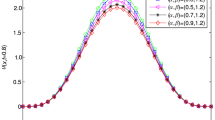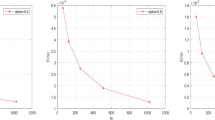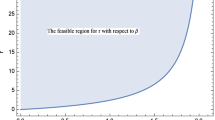Abstract
The asymptotic stable region and long-time decay rate of solutions to linear homogeneous Caputo time fractional ordinary differential equations (F-ODEs) are known to be completely determined by the eigenvalues of the coefficient matrix. Very different from the exponential decay of solutions to classical ODEs, solutions of F-ODEs decay only polynomially, leading to the so-called Mittag-Leffler stability, which was already extended to semi-linear F-ODEs with small perturbations. This work is mainly devoted to the qualitative analysis of the long-time behavior of numerical solutions. By applying the singularity analysis of generating functions developed by Flajolet and Odlyzko (SIAM J. Disc. Math. 3(2), 216–240, 1990), we are able to prove that both \(\mathcal {L}\)1 scheme and strong A-stable fractional linear multistep methods (F-LMMs) can preserve the numerical Mittag-Leffler stability for linear homogeneous F-ODEs exactly as in the continuous case. Through an improved estimate of the discrete fractional resolvent operator, we show that strong A-stable F-LMMs are also Mittag-Leffler stable for semi-linear F-ODEs under small perturbations. For the numerical schemes based on \(\alpha\)-difference approximation to Caputo derivative, we establish the Mittag-Leffler stability for semi-linear problems by making use of properties of the Poisson transformation. The new results and analyses provide not only the rigorous justifications and explanations of the Mittag-Leffler stability of numerical solutions with exact decay rate, but also establish some close connection between the continuous and discrete F-ODEs. Numerical experiments are presented for several typical time fractional evolutional equations, including time fractional sub-diffusion equations and semi-linear F-ODEs. All the numerical results exhibit the typical long-time polynomial decay rate, which is fully consistent with our theoretical predictions.



Similar content being viewed by others
Data availability
Data sharing is not applicable to this article as no datasets were generated or analyzed during the current study.
References
Cermák, J., Györi, I., Nechvátal, L.: On explicit stability conditions for a linear fractional difference system. Fract. Calc. Appl. Anal. 18(3), 651–672 (2015)
Cong, N.D., Doan, T.S., Tuan, H.T.: Asymptotic stability of linear fractional systems with constant coefficients and small time-dependent perturbations. Vietnam J. Math. 46, 665–680 (2018)
Cong, N.D., Tuan, H.T., Trinh, H.: On asymptotic properties of solutions to fractional differential equations. J. Math. Anal. Appl. 123759 (2019)
Cuesta, E., Palencia, C.: A numerical method for an integro-differential equation with memory in Banach spaces: qualitative properties. SIAM J. Numer. Anal. 41(4), 1232–1241 (2003)
Cuesta, E.: Asymptotic behaviour of the solutions of fractional integro-differential equations and some time discretizations. Discrete Contin. Dyn. Syst. 277–285 (2007)
Diethelm, K.: The Analysis of Fractional Differential Equations: an Application-Oriented Exposition Using Differential Operators of Caputo Type. Springer (2010)
Flajolet, P., Odlyzko, A.: Singularity analysis of generating functions. SIAM J. Disc. Math. 3(2), 216–240 (1990)
Flajolet, P., Sedgewick, R.: Analytic combinatorics. Cambridge University Press (2009)
Garrappa, R.: Trapezoidal methods for fractional differential equations: theoretical and computational aspects. Math. Comput. Simul. 110, 96–112 (2015)
Giusti, A., Colombaro, I., Garra, R., Garrappa, R., Polito, F., Popolizio, M., Mainardi, F.: A practical guide to Prabhakar fractional calculus. Fract. Calc. Appl. Anal. 23(1), 9–54 (2020)
Hairer, E., Wanner, G.: Solving Ordinary Differential Equations II. Stiff and Differential-Algebraic Equations. Springer Series in Computational Mathematics (2nd ed.), Vol. 14, Springer, Berlin (1996)
Jin, B., Lazarov, R., Zhou, Z.: An analysis of the L1 scheme for the subdiffusion equation with nonsmooth data. IMA J. Numer. Anal. 36(1), 197–221 (2016)
Jin, B., Li, B., Zhou, Z.: Correction of high-order BDF convolution quadrature for fractional evolution equations. SIAM J Sci. Comput. 39(6), A3129–A3152 (2017)
Kato, T.: Perturbation theory for linear operators. Springer Science & Business Media (2013)
Kemppainen, J., Zacher, R.: Long-time behavior of non-local in time Fokker-Planck equations via the entropy method. Math. Mod. Method Appl. Sci. 29(02), 209–235 (2019)
Kopteva, N.: Error analysis of the L1 method on graded and uniform meshes for a fractional-derivative problem in two and three dimensions. Math. Comput. 88, 2135–2155 (2019)
Lahrouz, A., Hajjami, R., El Jarroudi, M., Settati, A.: Mittag-Leffler stability and bifurcation of a nonlinear fractional model with relapse. J. Comput. Appl. Math. 113247 (2020)
Li, L., Wang, D.: Complete monotonicity-preserving numerical methods for time fractional ODEs. Commun. Math. Sci. 19(5), 1301–1336 (2021)
Li, C.P., Zhang, F.R.: A survey on the stability of fractional differential equations. Eur. Phys. J. Spec. Top. 193(1), 27–47 (2011)
Liao, H., McLean, W., Zhang, J.: A discrete Grönwall inequality with applications to numerical schemes for subdiffusion problems. SIAM J. Numer. Anal. 57(1), 218–237 (2019)
Lizama, C.: The Poisson distribution, abstract fractional difference equations, and stability. Proc. Amer. Math. Soc. 145(9), 3809–3827 (2017)
Lv, C., Xu, C.: Error analysis of a high order method for time-fractional diffusion equations. SIAM J. Sci. Comput. 38(5), A2699–A2724 (2016)
Lubich, C.: Fractional linear multistep methods for Abel-Volterra integral equations of the second kind. Math. Comput. 45(172), 463–469 (1985)
Lubich, C.: A stability analysis of convolution quadrature for Abel-Volterra integral equations. IMA J. Numer. Anal. 6(1), 87–101 (1986)
Lubich, C.: Convolution quadrature and discretized operational calculus. I. Numer. Math. 52(2), 129–145 (1988)
Lubich, C., Sloan, I., Thomée, V.: Nonsmooth data error estimates for approximations of an evolution equation with a positive-type memory term. Math. Comput. 65(213), 1–17 (1996)
Matignon, D.: Stability results for fractional differential equations with applications to control processing, Computational Engineering in Systems Applications. Lille, France: IMACS, IEEE-SMC 2, 963–968 (1996)
Ponce, R.: Time discretization of fractional subdiffusion equations via fractional resolvent operators. Comput. Math. Appl. 80(4), 69–92 (2020)
Podlubny, I.: Fractional Differential Equations. Academic Press, London (1998)
Stynes, M.: A survey of the L1 scheme in the discretization of time-fractional problems. RearchGage (2021). https://doi.org/10.13140/RG.2.2.27671.60322
Tang, T., Yu, H., Zhou, T.: On energy dissipation theory and numerical stability for time-fractional phase-field equations. SIAM J. Sci. Comput. 41(6), A3757–A3778 (2019)
Wang, D., Xiao, A., Zou, J.: Long time behavior of numerical solutions to fractional nonlinear ODEs, ESAIM: Math. Model. Numer. Anal. 54(1), 335–358 (2020)
Wang, D., Zou, J.: Dissipativity and contractivity analysis for fractional functional differential equations and their numerical approximations. SIAM J. Numer. Anal. 57(3), 1445–1470 (2019)
Xu, D.: Second-order difference approximations for Volterra equations with the completely monotonic kernels. Numer. Algo. 81(3), 1003–1041 (2019)
Yan, Y., Khan, M., Ford, N.J.: An analysis of the modified L1 scheme for time-fractional partial differential equations with nonsmooth data. SIAM J. Numer. Anal. 56(1), 210–227 (2018)
Acknowledgements
The authors are grateful to Professor Lei Li (Shanghai Jiao Tong University) for many constructive discussions.
Funding
The first author was partially supported by the National Natural Science Foundation of China (with grant numbers 11871057, 91630205). The second author was substantially supported by Hong Kong RGC General Research Fund (projects 14306719 and 14306718). The second author is on the editorial board of Numerical Algorithms.
Author information
Authors and Affiliations
Corresponding author
Appendices
Appendix 1. Fractional calculus, Mittag-Leffler function, and Prabhakar function
The Caputo fractional derivative of order \(\alpha \in (0, 1)\) is given by [29]
where \(\mathcal {I}_{t}^{\alpha }y(t)=(k_{\alpha }*y)(t)=\frac{1}{\Gamma (\alpha )}\int _0^t \frac{y(s)}{(t-s)^{1-\alpha }}ds\) denotes the Riemann-Liouville integral and the stand kernel \(k_{\alpha }(t)=\frac{t^{\alpha -1}}{\Gamma (\alpha )}\). We recall the Mittag-Leffler functions \(E_{\alpha }(z)\) and \(E_{\alpha ,\beta }(z)\): \(E_{\alpha }(z)=\sum _{k=0}^{\infty }\frac{z^{k}}{\Gamma (\alpha k+1)},\, E_{\alpha ,\beta }(z)=\sum _{k=0}^{\infty }\frac{z^{k}}{\Gamma (\alpha k+\beta )}\), where \(\alpha ,\beta >0\) and \(z\in \mathbb {C}\), which can be seen as the fractional generalization of exponential functions and occur naturally in fractional calculus; see more details in [29]. For \(\alpha \in (0,1)\), these two functions have the asymptotic expansion
where \(\theta \in (\frac{\alpha \pi }{2}, \pi \alpha )\). According to the expansion (A.1), one can prove that [2, 3]
where \(\lambda \in \Lambda _{\alpha }\) and \(C_1(\alpha ,\lambda ), C_2(\alpha ,\lambda )\) are real positive constants which are independent of t.
The Prabhakar function is the three-parameter generalization of Mittag-Leffler function defined as
where \((\gamma )_{k}=\Gamma (\gamma +k)/\Gamma (k)\) is the Pochhammer symbol. It is enough for our purpose to restrict the parameters \(\alpha ,\beta , \gamma \in \mathbb {R} ~\text {and}~\alpha >0\). In this case, \(E_{\alpha ,\beta }^{\gamma }(z)\) is an entire function of order \(\rho = 1/\alpha\). The key historical events and modern development and the main properties of Prabhakar function can be found in the most recent review paper [10]. We have \(E_{\alpha ,\beta }^{\gamma }(z)=E_{\alpha ,\beta }(z)\) for \(\gamma =1\), which recovers the Mittag-Leffler function. Generally, we have the reduction formula
Appendix 2. Estimate for \(D_n\) in (4.14) based on standard resolvent (4.5)
The integral path in (4.14) is firstly deformed to \(\Gamma _{(r, \theta )}\) defined in (4.3) and then split into two parts, \(\Gamma _{1}\) and \(\Gamma _{2}\), where \(\Gamma _{1}\) is the circle around the origin and \(\Gamma _{2}\) is two line segments. Then, the integral is naturally divided into \(D_{n} =D^{1}_{n}+ D^{2}_{n}\), where \(D_{n}^{j}\) \((j=1, 2)\) means the integral carried over \(z\in \Gamma _{j}\). One of the main reasons for choosing this contour is that the exponential function \(e^{z t_{n}}\) will decay as \(t_{n}\) increases for \(z\in \Gamma _{2}\). In order to estimate \(D^{j}_{n}\), we need to estimate three terms in the integral both for \(z\in \Gamma _{1}\) and \(z\in \Gamma _{2}\), namely, \(|e^{z t_{n}}|, \Vert (h^{-\alpha } F_{\mu } (e^{-zh}) I- A)^{-1}\Vert\) and |dz|, where \(F_{\mu } (z)=(1-z)^\alpha\) for F-BDF1.
We first consider \(D^{1}_{n}\) for \(z\in \Gamma _{1}\). Let \(z=re^{i\theta }=\frac{1}{t_{n}}e^{i\theta }\), where \(-\phi \le \theta \le \phi\) and \(\phi \in (\pi /2, \pi )\). By direct calculation, we can get that \(|e^{z t_{n}}|=|e^{\frac{1}{t_{n}}(\cos (\theta )+i\sin (\theta )) t_{n}}|= |e^{\cos (\theta )} |\le e\) and \(\int _{\Gamma _{1}}|dz|=\ell (\Gamma _{1}) \le 2\pi r\le \frac{C}{t_{n}}\), where \(\ell (\Gamma ^{1})\) is the length of \(\Gamma _{1}\). According to (4.5), we have \(\Vert (h^{-\alpha } F_{\mu } (e^{-zh}) I- A)^{-1}\Vert \le C |\frac{h^{\alpha }}{(1-e^{-zh})^{\alpha }}|\). On the other hand, there exist constants \(c_1, c_2>0\) such that \(c_{1}|zh|\le |1-e^{-zh}|\le c_{2}|zh|\) for \(z\in \Gamma _{1}\) [13], which yields that \(|\frac{h^{\alpha }}{(1-e^{-zh})^{\alpha }}| \le \frac{C}{|z|^{\alpha }}=\frac{C}{t_{n}^{\alpha }}.\) Combining the above bounds lead to
We now estimate \(D^{2}_{n}\). Let \(z=re^{i\phi }\), where \({1}/{t_{n}}\le r\le \pi /(h\sin (\phi ))\) and \(\phi \in (\pi /2, \pi )\). It follows by direct calculation that \(|e^{z t_{n}}|=|e^{r(\cos (\phi )+i\sin (\phi )) t_{n}}| =|e^{r\cos (\phi ) t_{n}}|= e^{r\cos (\phi ) t_{n}}\). Similarly to the above estimation of \(D^{1}_{n}\), there exist constants \(c_1, c_2>0\) such that \(c_{1}|zh|\le |1-e^{-zh}|\le c_{2}|zh|\) for \(z\in \Gamma _{2}\), which yields that \(|\frac{h^{\alpha }}{(1-e^{-zh})^{\alpha }}| \le \frac{C}{|z|^{\alpha }}=\frac{C}{r^{\alpha }}.\) Combining the above bounds and the simple transformation \(s=rt_{n}\), we can derive
Therefor, we conclude that \(\Vert D_{n}\Vert \le \Vert D^{1}_{n} \Vert +\Vert D^{2}_{n} \Vert =O(t_{n}^{\alpha -1})\) as \(t_{n}\rightarrow \infty .\)
From the above analysis, we see that \(\Vert D^{1}_{n} \Vert =O(t_{n}^{-\alpha -1})\). However, for \(D^{2}_{n}\) with \(z\in \Gamma _{2}\), this method only gives that \(\Vert D^{2}_{n} \Vert =O(t_{n}^{\alpha -1})\), hence resulting in the estimate \(\Vert D_{n}\Vert =O(t_{n}^{\alpha -1})\) or a reduction of the decay rate. In this case, the sum of the series \(\sum _{n=1}^{\infty }\Vert D_{n}\Vert\) diverges. This is not satisfactory and cannot be used to establish the long-time decay of numerical solutions.
Rights and permissions
Springer Nature or its licensor holds exclusive rights to this article under a publishing agreement with the author(s) or other rightsholder(s); author self-archiving of the accepted manuscript version of this article is solely governed by the terms of such publishing agreement and applicable law.
About this article
Cite this article
Wang, D., Zou, J. Mittag–Leffler stability of numerical solutions to time fractional ODEs. Numer Algor 92, 2125–2159 (2023). https://doi.org/10.1007/s11075-022-01379-8
Received:
Accepted:
Published:
Issue Date:
DOI: https://doi.org/10.1007/s11075-022-01379-8
Keywords
- Fractional ODEs
- Mittag-Leffler stability
- Polynomial decay rate
- Fractional LMMs
- \(\mathcal {L}\)1 scheme
- \(\alpha\)-difference




